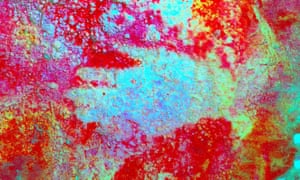SO NEANDERTHALS MADE ABSTRACT ART? ASTOUNDING DISCOVERY HUMBLES EVERY HUMAN by Jonathan Jones
Leaving a mark … a color-enhanced hand stencil from La Pasiega in
northern Spain, now dated back 66,700 years. Photograph: Reuters
If you go to the painted caves of Spain and France, crawl through narrow passages and keep your balance on slippery rock floors, you reach the hidden places where ice age hunters made their marks tens of thousands of years ago. Nothing seems more startling than the way they placed hands against the cold rock and blew red ochre out of their mouths to leave fiery images. Of what though?
Up to now we called it the human presence. “The print of the hand says, ‘This is my mark. This is man’,” declared the scientist Jacob Bronowski when he visited caves in northern Spain in his classic TV series The Ascent of Man. Simon Schama visits those same caves in the BBC’s new epic series Civilisations and raves about those same handprints. For what could communicate the curiosity, self-assertion, intelligence, and above all self-consciousness of our unique species Homo sapiens, more clearly that this desire to literally leave our mark?
Drawing of Panel 78 in La Pasiega by Breuil et al (1913). The red scalariform (ladder) symbol has a
minimum age of 64,000 years but it is unclear if the animals and other symbols were painted later
Except it is not unique to Homo sapiens at all. The potentially epoch-making announcement in the journal Science this week of a new dating for art in some of Spain’s painted caves includes the astounding discovery that a stencilled hand in Maltravieso cave is at least 66,700 years old – a date reached by testing the calcite deposits that have encrusted it over the millennia.
That is long before modern humans are known to have reached Europe on their migration out of Africa. It is also more than 25,000 years before the first paintings made by Homo sapiens in Europe were created at Chauvet in France. The Maltravieso hand is not human, at least not Homo sapiens. It has to be that of a Neanderthal, the early species that hunted the big beasts of ice age Europe before our lot came along, only to mysteriously vanish about 40,000 years ago, soon after our arrival.
“Up to now there have been claims of Neanderthals doing cave art,” says Professor Chris Stringer, Britain’s foremost authority on human evolution. “But it could well have been modern humans. This is clearly before the time when humans were in Europe.” Stringer, one of the researchers who established the now extremely well-proven theory that Homo sapiens evolved in Africa, was not involved in the new dating work but accepts the findings are “a huge breakthrough”.
READ THE REST AT THE GUARDIAN OR ATJ
Also, if you want to go to the horse's mouth,
here's the SCIENCE journal article.

